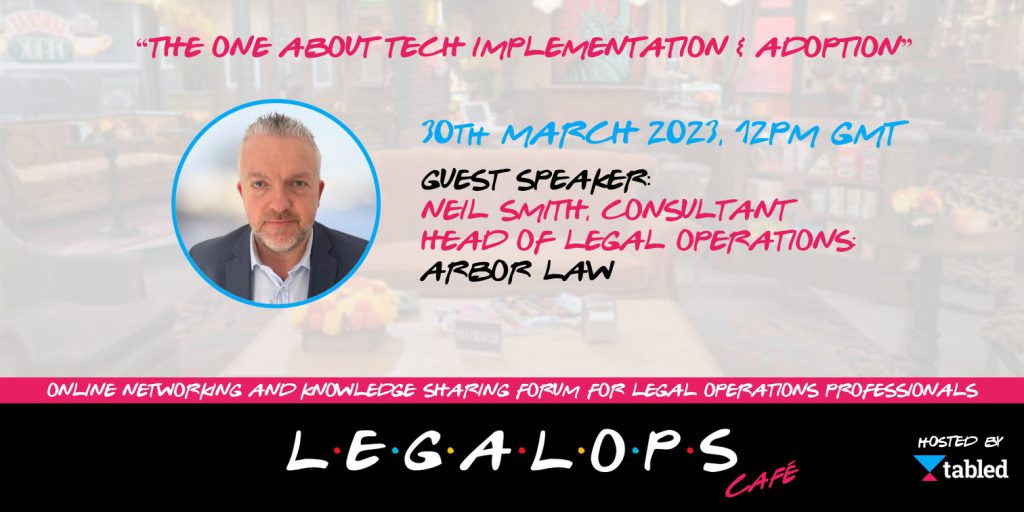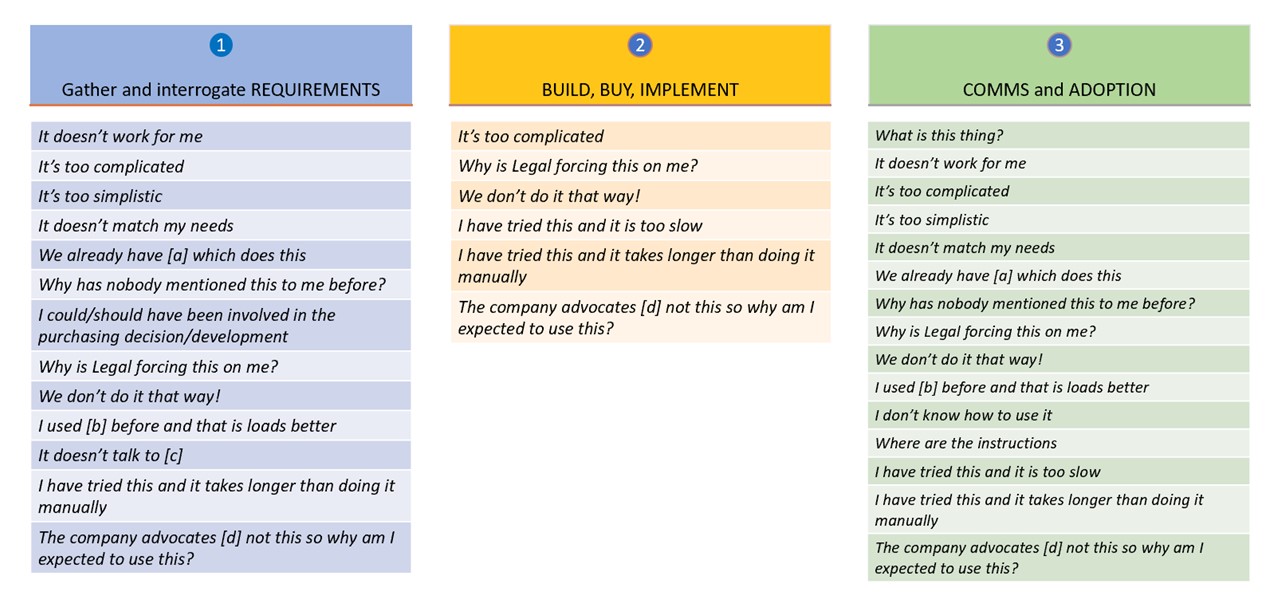
The Legalops Café is a growing community hosted by Tabled for legal operations professionals and inhouse counsel looking to network and share insights.
To receive updates and invitations to future LegalOps Cafe sessions please sign up here.
Our March session of the Legalops Café was “The One About Tech Implementation & Adoption”. Special thanks to our guest speaker, Neil Smith who is Head of Legal Operations Consulting at Arbor Law, for an informative presentation and discussion.
In this post, we’ll be rounding up some of the key takeaways from the session.

The Legalops Café is a growing community hosted by Tabled for legal operations professionals and inhouse counsel looking to network and share insights.
To receive updates and invitations to future LegalOps Cafe sessions please sign up here.
Our March session of the Legalops Café was “The One About Tech Implementation & Adoption”.
Special thanks to our guest speaker, Neil Smith who is Head of Legal Operations Consulting at Arbor Law, for an informative presentation and discussion.
In this post, we’ll be rounding up some of the key takeaways from the session.
A successful technology rollout project starts (or should!) even before the technology itself is identified and continues past implementation. Neil suggested that the process can be broken down into 3 principal phases:
1) Gather & Interrogate Requirements
2) Build/Buy, Implement
3) Comms & Adoption
Giving insufficient thought to the above before embarking on a tech implementation can lead to a number of negative consequences at the rollout stage.
For instance, Neil shared this list of objections you might encounter:

As can be seen, these can all be mapped back to one (and in several cases two or more) of the three phases set out above.
For example, if a user’s complaint is that the system “doesn’t work for me”, this could be rooted in issues that arose during any of the three phases e.g.
– Did one or more relevant requirements slip through the net?
– Was a use case inadvertently overlooked?
– Is the user using the tool correctly?
– Is the tool not behaving as it should?
– Has this issue been escalated?
– Are the user instructions sufficiently clear on this point?
– Was this particular user (or another with a sufficiently similar profile) involved in the testing?
– Has sufficient time (and energy!) been spent on comms and adoption?
With that mind, Neil went on to share tips and insights for success at each key stage–.
It can be tempting to jump straight into looking for a solution without having fully identified the challenge(s) you need to solve and the outcomes(s) you wish to achieve. However, doing this typically causes problems later in the process such as:
– All relevant use cases not fully factored in
– Low use, buy-in and adoption
– User complaints as per the above
– Lack of faith in the process
– Negative perceptions re the tech solution itself
– Unforeseen integration issues with other applications
It is therefore important to start by producing an accurate and comprehensive list of the requirements your technology solution will be required to meet.
Neil stressed the importance of going into as much detail as you can and being careful to arrive at a holistic view which reflects the different needs and perspectives of all relevant stakeholders. It should also be made clear how the requirements will tangibly benefit the business at large, not just the legal team.
This is relevant to securing buy-in to your business case for whatever solution(s) you ultimately want to introduce and, indeed, whether you take the decision to build your solution (using existing tools such as SharePoint, MS forms, Teams functionality) or a buy a bespoke solution.
For all of the above it is vital to ensure you have the right people ‘in the room’. One tip is to identify key stakeholders/beneficiaries (including senior management and the procurement team if you have one) and create a Steering Committee for the project.
Also very helpful at this stage can be the judicious use of surveys, interviews and focus groups. This can also flush out metrics and KPIs which stakeholders and beneficiaries would like to be able to see and leverage post-implementation: a fantastic tool for getting buy-in.
When it comes to implementation, you should be wary of seeking all-encompassing perfection at roll out.
Neil suggested a set of three ‘golden questions’ which can help you to stay on track during this (and indeed any) phase of a tech implementation project:
1) Where are you now?
2) Where do you want to be?
3) How will we get there?
Ask these questions with your requirements analysis in mind and identify the approach / use case(s) that will give you the biggest ‘bang for your buck’ on day one.
From that point on, the best approach will usually be to run an iterative implementation process, engaging in a continuous cycle of feedback and improvement.
Whilst never easy at the implementation stage, Neil suggested that you should not be overly afraid to fail – it is easier to course correct at the beginning than it is when the project is more embedded. You should also remain receptive and open minded throughout to ensure that the tool is fully optimised and remains fit for purpose.
Where comms supporting adoption are concerned ‘more is better’. Use the broadest range of comms channels and formats available – emails, live clinics and training, supplier-led demos and self-service resources e.g. training videos and self-help guides on the intranet.
That said, finding ways to fit your comms into users’ normal ways of working and BAU meetings – particularly if you can recruit colleagues across the business to act as internal champions – can really help to spread and amplify your messaging.
This can be especially effective as an adoption-accelerator if your champions run live demos by reference to use cases they have completed in ‘real life’.
Where 3rd party tech is concerned, your vendor will (or should!) have a vested interest in helping you to succeed. They will be able to help with messaging and training to drive adoption.
More adoption means more data to articulate how the technology is producing a positive ROI for the business. This will in turn help to reinforce buy-in from the business and drive adoption amongst those who are slower to adopt.
Ongoing communication with key stakeholders will also be important for identifying any weak spots and/or opportunities for improvement.
Your ultimate goal should be for new technology and the processes that surround it to become as ‘BAU’ (business as usual) as possible. It is therefore important to ensure that your adoption plan identifies (and prepares) those people who will be needed to ‘keep the lights on’ post-implementation.
Thanks again to Neil Smith of Arbor Law for sharing his tips and insights with the group.
As technology vendors, we understand that having a great product is only part of the story when it comes to successful roll-out and adoption. As Neil illustrated with his 3-part framework, the process is multi-faceted and starts well before a solution is rolled out.
Properly identifying requirements, engaging the right stakeholders (at the right time and in the right way) and taking an agile, iterative approach to implementation will all help to secure a positive outcome.
Pair that with the right solution, from the right partner/provider and you should be very well placed to run a successful rollout, get buy-in across your organisation and reap the benefits going forward. If you’d like to learn more about the way Tabled works with customers to help plan and deliver successful rollouts please do get in touch.